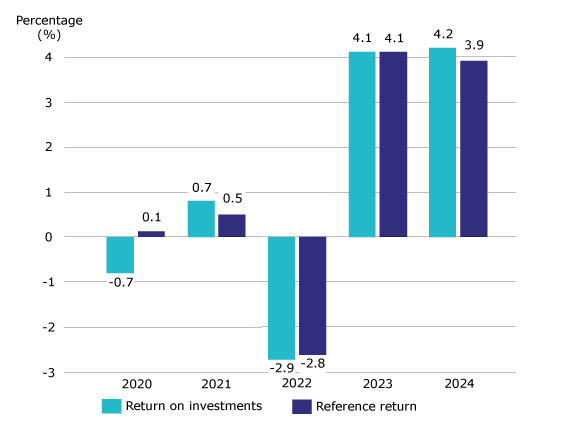Despite the lowering of unemployment insurance contributions,
the liquidity of Employment Fund is secured.
In 2024, there were significant changes in the operations of Employment Fund and at the same time, we set our sights to the future. Parliament approved the abolition of adult education benefits and as a result, we started the gradual phasing out of the benefits. Parliament also approved a number of changes reducing unemployment security expenditure. Amid the changes, we focused on carrying out of our statutory duties and set our sights to the future by updating the Fund’s strategy.
From now on, our vision is to be a respected and effective executor of social security. Our strategic goals are we produce customer oriented digital age services reliably and with high quality, and we increase productivity and efficiency. Our mission will remain unchanged as the Fund will continue to provide security for changes in working life.
The aim of our strategic development projects is to enhance our digital services, boost efficiency and productivity and to make our systems more capable and reliable. During the first half of 2024, we carried out a public IT purchase as a competitive dialogue, and started project implementation in the autumn of the year. The aim of the project, in which the focus is on developing IT platform services, is to ensure that we can continue to provide our customers, stakeholders and personnel with up-to-date, user-friendly, reliable and secure digital solutions and services.

Janne Metsämäki
Managing Director
Year 2024 in figures | Year 2024 in a nutshell | Personnel | Contributions and allowances | Finance | Investment activities | Previous publications
Unemployment insurance contributions were substantially lowered for the year 2024 and further in 2025.
The average employer's unemployment insurance contribution was 0.82% in 2024 and 0.61 in 2025. The average employee’s unemployemtn insurance contribution was 0.79% in 2024 and 0.59 in 2025.
With the second consecutive year of lower contributions, unemployment insurance contributions will be less than half of the 2023 levels in 2025. Despite the reductions, the liquidity of Employment Fund is secured.

The year of the adult education benefits was characterised by the implementation of the abolition set out in the Government Programme. The abolition prompted a record number of applications during the early months of the year.
The act entered into force in June and led to a dramatic drop in the number of applicants. We shifted the focus from developing the benefits online service to high-quality advice and support.
Ensuring customer satisfaction was our key goal in the challenging change situation, and the objective was fully met in 2024.

In our role as a provider of funding for social security, we put great emphasis on social responsibility themes.
We promote the sustainable development goals set out in the UN 2030 Agenda, in particular by ensuring sustainable funding of unemployment security, by effective implementation of adult education benefits, and by observing and developing the principles of good governance in the Fund.
In 2024, we focused on defining the indicators for sustainable reporting and planning measures.
Read our sustainability report on page 43
During the year, we invested in the development of staff competence, especially by supporting working life and digital skills. We provided our personnel with comprehensive internal training and external coaching, both in-house and on line. In supporting wellbeing, we focused on preventive occupational health care and maintaining of work ability.
The impacts of these measures were positively reflected in the feedback given by our employees: the employees felt that their competence and wellbeing are also a priority in a challenging change situation.
In autumn 2024, we also launched an extensive identity project and will continue to incorporate its results in our daily work in 2025. The aim of identity work is to ensure that each Fund staff member has understanding of the identity and future direction of Employment Fund and that a defined identity helps the employees in everyday work.
Entry into force of the act abolishing the adult education benefits on 1 June 2024 was the most significant change of the year from the perspective of personnel management. Already during the transition period, the legislative amendment has had an impact on the structure, operations and human resources of the service areas providing benefit services and support functions. Due to the abolition of the adult education benefits, 58% of the employment relationships of the persons working in benefit services ended and 13% of the employees moved to other positions within the organisation during 2024. The actual personnel impacts will become clear once the transition period has ended.
The abolition of the adult education benefits has had significant impacts on the Fund’s staff members working in customer service tasks and in customer service support. Despite the demanding change situation, implementation of the adult education benefits and customer advice have been excellently managed, thanks to a fully digitalised application process, a high degree of automation and change-capable personnel.
Although one of our tasks is ending, the Fund will continue to manage its other statutory tasks. In 2024, we updated the organisational structure of our Technology and Development service area and also strengthened our IT services through recruitment. The pace of technological development is accelerating and requires a change capability, which can only be maintained with a strong IT organisation that can better meet the current and future needs of our business operations.
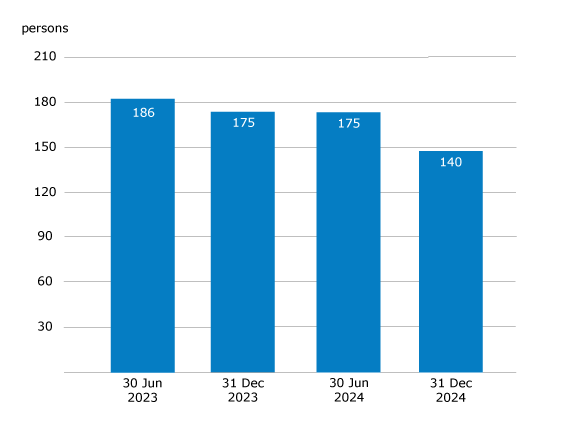
The unemployment insurance contributions paid by employers totalled EUR 766 (1,412) million in 2024. The liability components and transition security contributions paid by employers, and the deductions specified in the Employment Contracts Act totalled EUR 24 (21) million. The unemployment insurance contributions paid by employees totalled EUR 806 (1,490) million.
The unemployment insurance contributions were lowered according to our proposal for the year 2024 and again for 2025. The proposal for lowering the contributions was made possible by the improving outlook for the economy and employment, the assets accrued in our business cycle buffer and the estimated impact of the measures set out in the Government Programme.
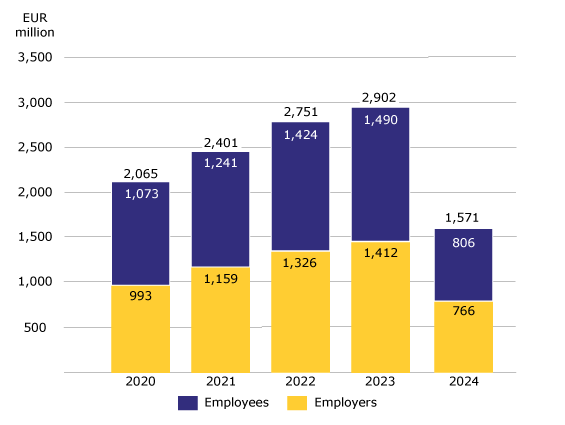
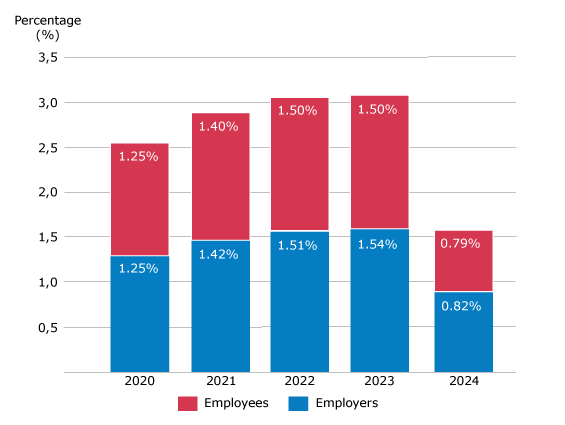
We provided EUR 3,129 (2,900) million for the financing of unemployment security, pension security and adult education benefits. The benefits financed by us include the unemployment allowances paid by unemployment funds and the Social Insurance Institution of Finland. Until the end of 2025 we finance adult education allowance and the scholarships for qualified employees, which are also paid directly by us. We are also responsible for financing the earnings-related pensions accrued during the periods when daily unemployment allowances, job alternation compensation and adult education allowances are paid as well as the transition security scheme.
We remit a payment amounting to the basic daily allowance paid by the state to contribute to the daily unemployment allowances
paid by unemployment funds. Together, these account for about 94.5% of the financing of unemployment funds. The remainder
of the financing comes from the membership contributions.
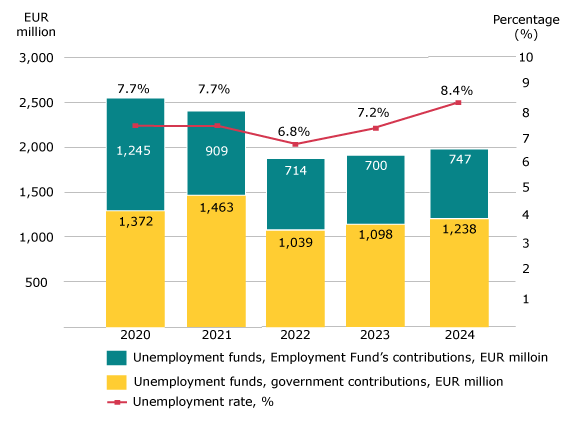
A total of EUR 212.2 (201.1) million in adult education allowance and scholarships for qualified employees was granted in 2024. The amount of the adult education benefits granted increased by 5.5% compared to 2023.
We paid a total of EUR 202.7 (189.3) million in adult education benefits to 31,796 (32,518) persons. Of the recipients, 1,104 (1,079) received entrepreneurs’ adult education benefits and 30,694 (31,439) received employees’ adult education benefits.
We granted scholarships for qualified employees to 23,009 (28,485) persons in 2024. We paid a total of EUR 9.6 (11.8) million in scholarships, which was the lowest amount in the last five years.
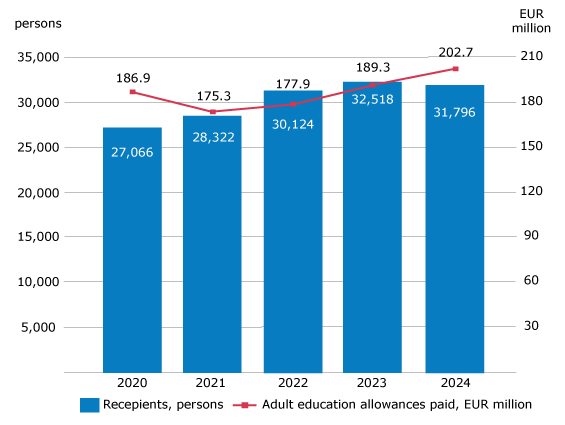
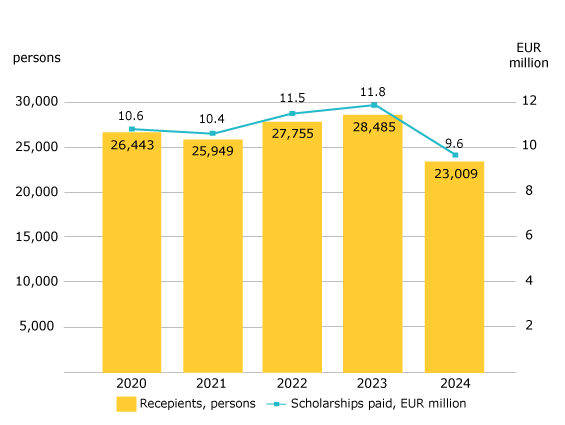
The business cycle buffer accrues on the basis of the difference between Employment Fund’s assets and liabilities. When the unemployment insurance contributions are set, the forecast for the maximum amount of assets or liabilities in the buffer may not exceed expenses corresponding to an unemployment rate of six percentage points. When the decision on the level of unemployment insurance contributions is made, the forecast for the business cycle buffer may by law exceed the maximumamount of assets over two years during a three-year review period to ensure a steady payment trend. In that case, however, unemployment insurance contributions may not be set higher than in the previous year.
The maximum amount of the buffer is calculated on the basis of the annual financialstatements by dividing the annual expenses for which Employment Fund is liable (EUR 2,416 million in 2024) by the average unemployment rate for the year (8.4%), and multiplying the result by six.
The maximum amount of the business cycle buffer allowed by law was EUR 1,726 (1,861) million in 2024.
Change in the Fund’s net position was EUR 749 million negative (EUR 763 million positive) in 2024. The Fund’s net position totalled EUR 1,272 million on 31 December 2024 (EUR 2,021 million on 31 December 2023).
When preparing our financial statements for 2024, we estimated that the change in Employment Fund’s net position would be aboutEUR 600 million negative in 2025, which would mean a positive net position of about EUR 670 million at the end of 2025.
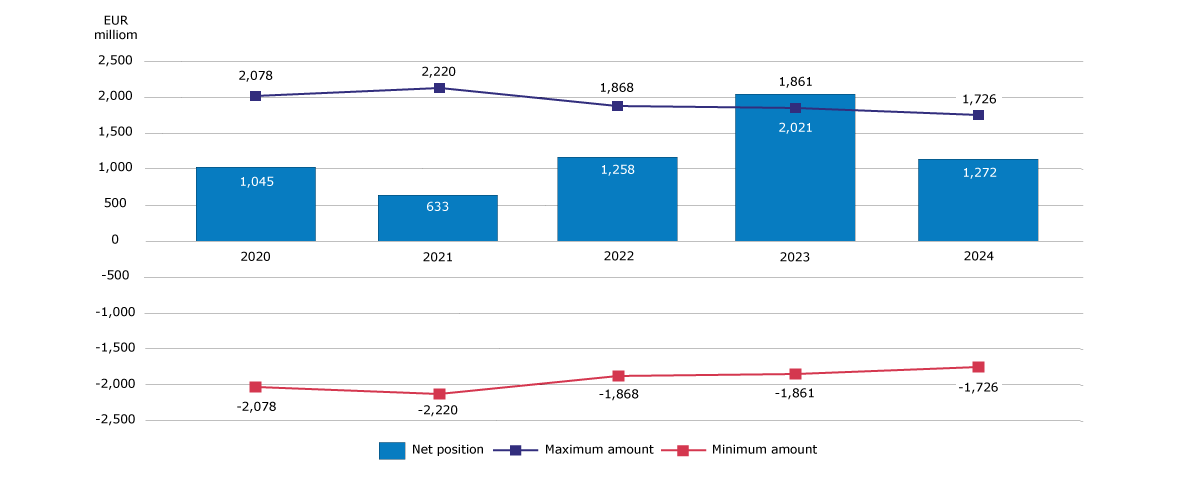
| Income | 2020 | 2021 | 2022 | 2023 | 2024 | Change EUR | Change % |
| Unemployment insurance contribution income collected from employers | 993 | 1,159 | 1,326 | 1,412 | 766 | -647 | -46% |
| Unemployment insurance contribution income collected from employees | 1,073 | 1,241 | 1,424 | 1,490 | 806 | -684 | -46% |
| Government contributions | 1,248 |
911 |
717 | 704 | 752 | 47 | 7% |
| Other employer contributions* | 27 | 23 | 23 | 21 | 24 | 3 | 17% |
| Total income | 3,340 | 3,335 | 3,490 | 3,627 | 2,347 | -1,280 | -35% |
| Expenses | 2020 | 2021 | 2022 | 2023 | 2024 | Change EUR | Change % |
| Unemployment funds, Employment Fund’s contributions | -1,372 | -1,463 | -1,039 | -1,098 | -1,238 | 140 | 13% |
| Unemployment funds, government contributions | -1,245 | -909 | -714 | -700 | -747 | 47 | 7% |
| Finnish Centre for Pensions | -870 | -902 | -596 | -600 | -722 | 123 | 20% |
| Social Insurance Institution of Finland | -207 | -239 | -243 | -263 | -168 | -95 | -36% |
| Adult education benefits | -197 | -186 | -189 | -201 | -212 | 11 | 6% |
| Ministry of Economic Affairs and Employment | -25 | -14 | -20 | -30 | -32 | 2 | 5% |
| State Pension Fund | -9 | -11 | -8 | -8 | -10 | 2 | 28% |
| Administrative expenses | -21 | -26 | -23 | -34 | -34 | 1 | 2% |
| Total expenses | -3,947 | -3,750 | -2,832 | -2,934 | -3,163 | 229 | 8% |
| Net financial income | -16 | 3 | -34 | 69 | 67 | -2 | -4% |
| Change in net position | -623 | -412 | 625 | 763 | -749 | -1,512 |
| Net position | 2020 | 2021 | 2022 | 2023 | 2024 | Change EUR | Change % |
| Investment assets and cash and cash equivalents | 1,831 | 1,339 | 1,885 | 1,869 | 1,513 | -356 | -19% |
| Receivables, accruals and fixed assets | 593 | 679 | 818 | 859 | 447 | -413 | -48% |
| Short-term and long-term loans | 1,287 | 1,299 | 1,299 | 599 | 599 | 0 | 0% |
| Unemployment insurance contribution and other liabilities | 92 | 86 | 146 | 109 | 89 | -20 | -18% |
| Net position | 1,045 | 633 | 1,258 | 2,021 | 1,272 | -749 | -37% |
*Other employer contributions contain the employer’s liability component and transition security contributions and the deductions under the Employment Contracts Act.
Employment Fund carries out investment activities to the extent necessary to manage the timing differences in the cash flows generated by its income and expenses, and for liquidity management purposes.
In 2024, the return on our investments was 4.2% (4.1%). The return exceeded the expectation of 3.6% (2.8%) entered in our investment plan and the reference return on our investment activities, which was at 3.9% (4.1%).
Sustainable investment means that when we make investment decisions, we take environmental, social and governance (ESG) factors into consideration in addition to financial indicators. With the exception of index investments, we integrate ESG factors into all our investments insofar as is possible. An external party reviews our investments twice a year and reports any deviations.
We exclude companies whose operating methods are considered irresponsible with regard to factors such as corruption, child labour, employees’ rights and human rights from our list of potential investments. We invest in companies that comply with the UN Global Compact wherever possible.

